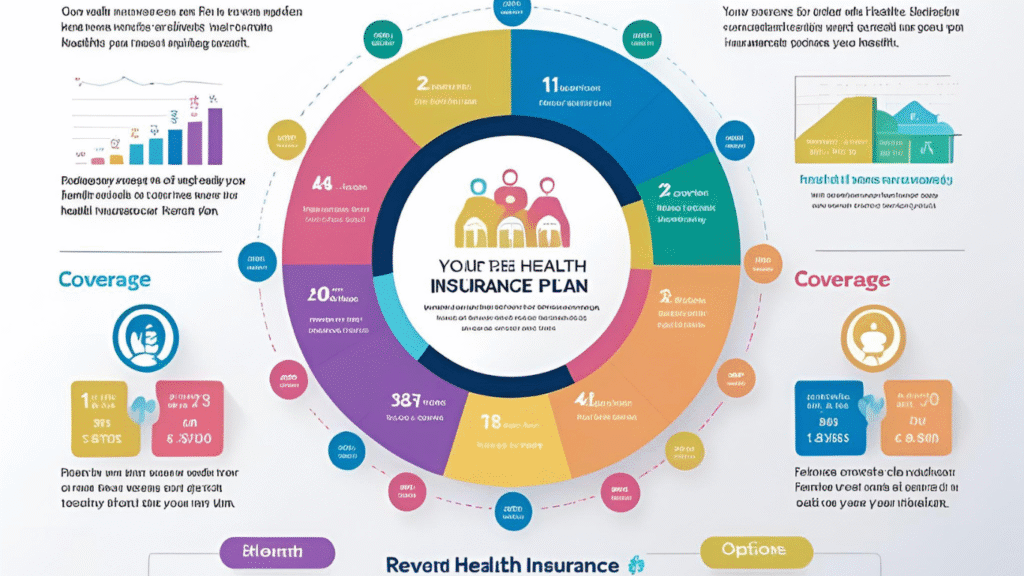Step-by-Step Guide to Getting the Coverage You Need
Choosing a health insurance plan in the U.S. can feel overwhelming — filled with confusing terms, fine print, and hard-to-compare options. Whether you’re shopping on the marketplace, choosing through an employer, or evaluating private options, making the right decision is critical to both your health and your finances.
This guide will walk you through the key steps and factors to consider so you can confidently choose the best health insurance plan for your needs.
Why Health Insurance Matters
In the U.S., medical care can be extremely expensive without insurance. A trip to the ER or a hospital stay can cost thousands — even for minor issues. Health insurance helps you:
- Access preventive and emergency care
- Manage chronic conditions
- Avoid crushing medical debt
- Get discounted rates through provider networks
🔍 Step 1: Understand the Types of Plans
Start by learning the main types of health insurance plans:
1. HMO (Health Maintenance Organization)
- Requires a primary care doctor (PCP)
- Needs referrals to see specialists
- Lower cost, but less flexibility
- Best for: People who prefer lower premiums and are okay staying in-network
2. PPO (Preferred Provider Organization)
- More flexibility to see any doctor
- No referral needed for specialists
- Higher premiums, but more provider options
- Best for: Those who want freedom to see out-of-network doctors
3. EPO (Exclusive Provider Organization)
- Lower premiums, no referrals needed
- No out-of-network coverage (except emergencies)
- Best for: Budget-conscious users okay with a limited network
4. HDHP (High Deductible Health Plan)
- Low monthly premiums, high deductibles
- Often paired with an HSA (Health Savings Account)
- Best for: Healthy individuals who rarely go to the doctor
💵 Step 2: Compare Plan Costs — Not Just Premiums
When comparing plans, don’t stop at the monthly premium. Consider these five key cost factors:
| Cost Term | What It Means |
|---|---|
| Premium | What you pay each month to have coverage |
| Deductible | What you pay out-of-pocket before insurance kicks in |
| Copay | Fixed amount for doctor visits, prescriptions, etc. |
| Coinsurance | % you pay after deductible is met |
| Out-of-pocket max | The most you’ll pay per year before insurance covers 100% |
➡️ Pro Tip: If you expect frequent doctor visits or prescriptions, a higher premium may save you money in the long run with lower out-of-pocket costs.
🩺 Step 3: Check the Provider Network
Ask yourself:
- Are your current doctors in-network?
- Are the hospitals and specialists you prefer included?
- What’s the network coverage in your area (especially if you live rurally)?
Going out of network can be very expensive, or not covered at all in some plans like HMOs or EPOs.
💊 Step 4: Review Covered Services & Prescription Benefits
Make sure the plan covers the services you need:
- Preventive care (vaccines, screenings)
- Mental health services
- Specialist visits
- Maternity and newborn care
- Prescription drugs
Also, check the formulary (drug list) to see if your medications are covered and what tier they’re in — this impacts cost.
👨👩👧👦 Step 5: Consider Your Personal or Family Needs
Ask yourself:
- Do you or a family member have a chronic condition?
- Do you anticipate pregnancy, surgery, or other major needs this year?
- Are you mostly healthy and want to pay less up front?
A plan that works well for a healthy 25-year-old won’t be ideal for a family with kids or someone managing diabetes.
📆 Step 6: Choose the Right Time to Enroll
Here are the typical enrollment windows:
- Open Enrollment (Marketplace/ACA): Usually Nov–Jan annually
- Employer Coverage: Enrollment period varies by employer
- Special Enrollment: You qualify outside open enrollment if you experience a life event like marriage, job loss, or having a baby
Don’t miss these windows — or you might be stuck without coverage.
✅ Summary Checklist: Choosing the Right Plan
Before you decide, check off these key questions:
- Do I understand the plan type (HMO, PPO, etc.)?
- Can I afford the monthly premium and out-of-pocket costs?
- Are my doctors and hospitals in-network?
- Are my prescriptions covered affordably?
- Does this plan meet my medical and family needs?
- Am I choosing coverage during the correct enrollment period?
🧩 Final Thoughts
The “right” health insurance plan isn’t one-size-fits-all — it’s the one that fits your budget, health needs, and lifestyle. Take your time to compare, read the fine print, and ask questions if you’re unsure. Being proactive now can save you thousands — and a lot of stress — later.
📚 Useful Resources
- Healthcare.gov – Marketplace Enrollment
- KFF Health Plan Comparison Tool
- State Health Insurance Assistance Programs (SHIP)

Silvia Heart is a lifestyle and wellness writer with a background in apparel and a degree in fashion. She blends creativity with practical insights, guiding readers toward intentional, balanced living. Through her approachable style and thoughtful storytelling, Silvia inspires her community to embrace both everyday joy and personal growth.


